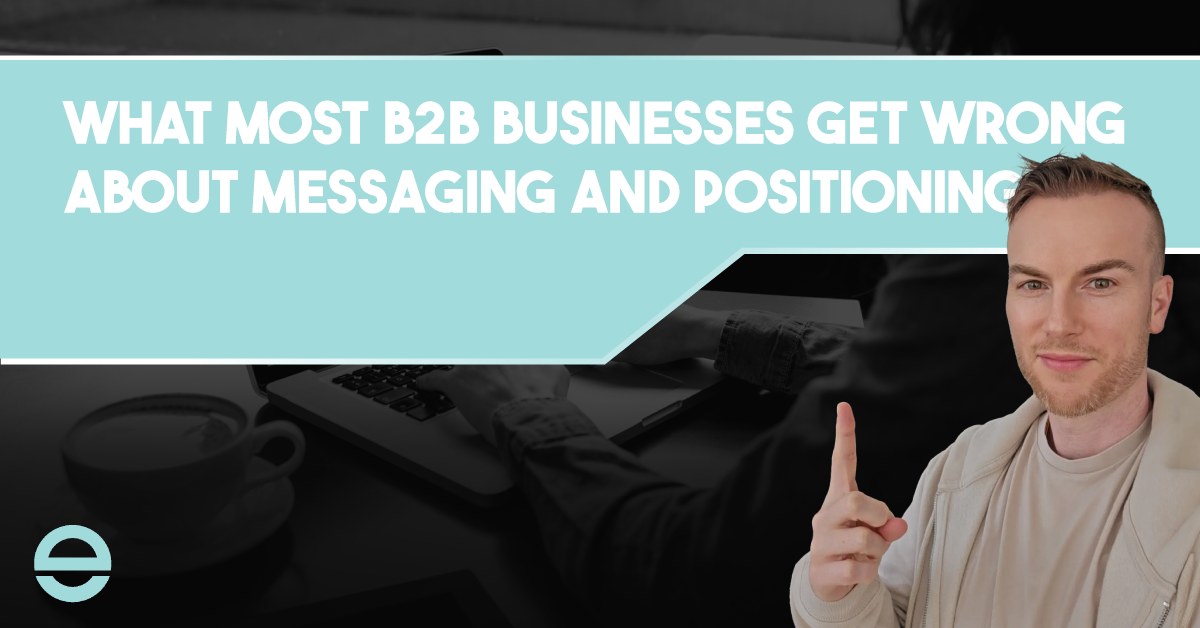
Businesses know they need to stand out — but far too often, they stumble in how they communicate what sets them apart. The reality is that getting messaging and positioning right requires more than catchy phrases or impressive-sounding claims.
In this post, we’ll explore some of the most common missteps businesses make in their messaging and positioning and discuss strategies for getting it right.
Most B2B Businesses Get This Wrong About Messaging and Positioning
So many B2B companies get their 𝐦𝐞𝐬𝐬𝐚𝐠𝐢𝐧𝐠 and 𝐩𝐨𝐬𝐢𝐭𝐢𝐨𝐧𝐢𝐧𝐠 all wrong.
Are you trying to convince your buyer to enter your category, or to choose you?
There’s a big difference.
Messaging like “save time and money with our solution” is actually targeted at the category level. It’s generic.
It’s assuming your target consumer doesn’t yet have such a solution in their workflow and you’re trying to convince them they need it.
Would the consumer not save time and money by going with your direct competitor?
Is your competitor offering a solution that will cost them time and money? Not likely.
Messaging to choose 𝐲𝐨𝐮 is an acknowledgement that your target consumer is already convinced (or semi-convinced) they need a solution in your category, and now it’s about positioning your solution over your competitor.
What do you have that your competitor doesn’t?
Always assume you are competing with someone else.
People don’t browse B2B websites for fun. They are there to gather information, to compare and contrast, to be persuaded…
Your job then becomes:
- How are we positioned in our category to stand out among our competitors? What do we offer that they don’t?
- Craft your messaging (and other web assets) to convey that positioning and value proposition as clearly and concisely as possible.
Marketers will say you need to be outcomes or results based – using a JTBD framework – you look at pain points, triggers, and transformations (i.e. what’s at stake if they don’t find a solution).
These are all fine, but don’t stop there.
You need to be laser focused on how you stand apart among your toughest competition and do whatever is necessary to pry them out of your top competitor’s orbit.
👉 Think: “If I were a buyer for our solution, would I choose us?”
What Are Category Entry Points (CEPs)?
In marketing, Category Entry Points (CEPs) refer to the specific triggers, situations, needs, and mental cues that prompt consumers to think about or buy from a particular product category. CEPs are essentially the “doors” that bring customers into a category and connect them to brands in that space. By understanding CEPs, brands can position themselves more effectively at key moments when customers are open to making a purchase or engaging with a product.
Why Category Entry Points Matter
CEPs help marketers understand and influence customer behaviour by identifying the most likely scenarios, emotions, or needs that lead to a purchase decision. This knowledge helps brands position themselves to be top-of-mind when these situations arise.
For instance, a sports drink brand might focus on CEPs like “post-workout recovery,” “outdoor activities,” or “energy boosts,” to establish strong associations with these needs and stand out when consumers encounter them.
How to Identify Category Entry Points
- Analyze Customer Behaviour: Look at purchase patterns, feedback, and contexts in which customers decide to buy a product.
- Understand Usage Situations: Identify when, where, and why customers use products in your category.
- Assess Customer Pain Points: What issues or needs are common in the lives of your target audience that your product can solve?
- Monitor Competitor Positioning: Identify the scenarios where your competitors are focusing their marketing efforts.
Examples of Category Entry Points
For example, a coffee brand’s category entry points might include:
- Morning energy boost
- Social interactions or meetings
- Relaxation or “me-time” moments
- Alternative to an afternoon snack
By linking your brand to a range of CEPs, you increase the chances of being considered in a wider range of situations, ultimately building brand salience, which makes your brand easier for consumers to recall across different buying triggers.

Community Building for Brands
How do you make your brand stand out?
The answer lies in the age-old art of storytelling. Just as a perfect ball game keeps fans on the edge of their seats, a well-told story can captivate your audience, create emotional connections, and ultimately drive action.
The following was taken from the book, Three Uses of the Knife: On the Nature and Purpose of Drama, by David Mamet
What do we wish for in the perfect ballgame? Do we wish for our team to take the field and thrash the opposition from the first moment, rolling up a walkover score at the final gun?
No. We wish for a closely fought match that contains many satisfying reversals, but many of which can be seen retroactively to have always tended toward a satisfying and inevitable conclusion.
- Related post: The T-Shirt Theory of Branding
- Related post: The Power of Branding: John’s Family Premium Organic Garlic
- Related post: Why You Don’t Want to Run a Business that Relies Solely on Ads


Continue reading: What’s the ROI of a Billboard








